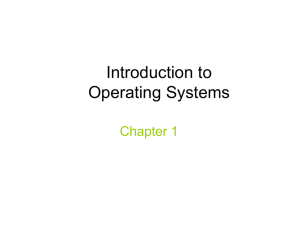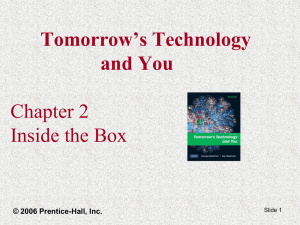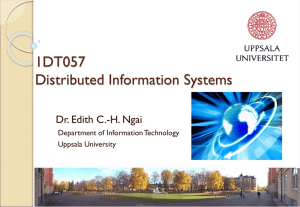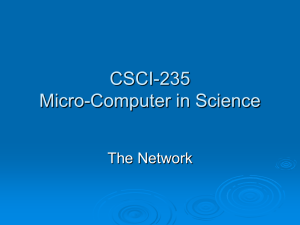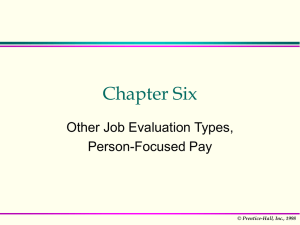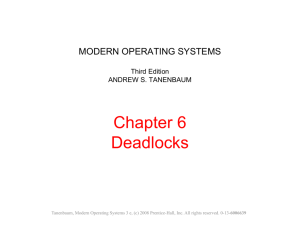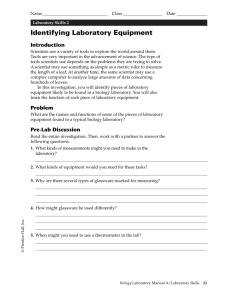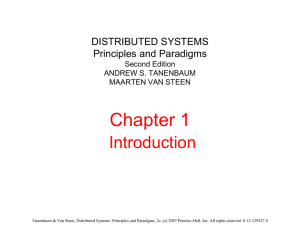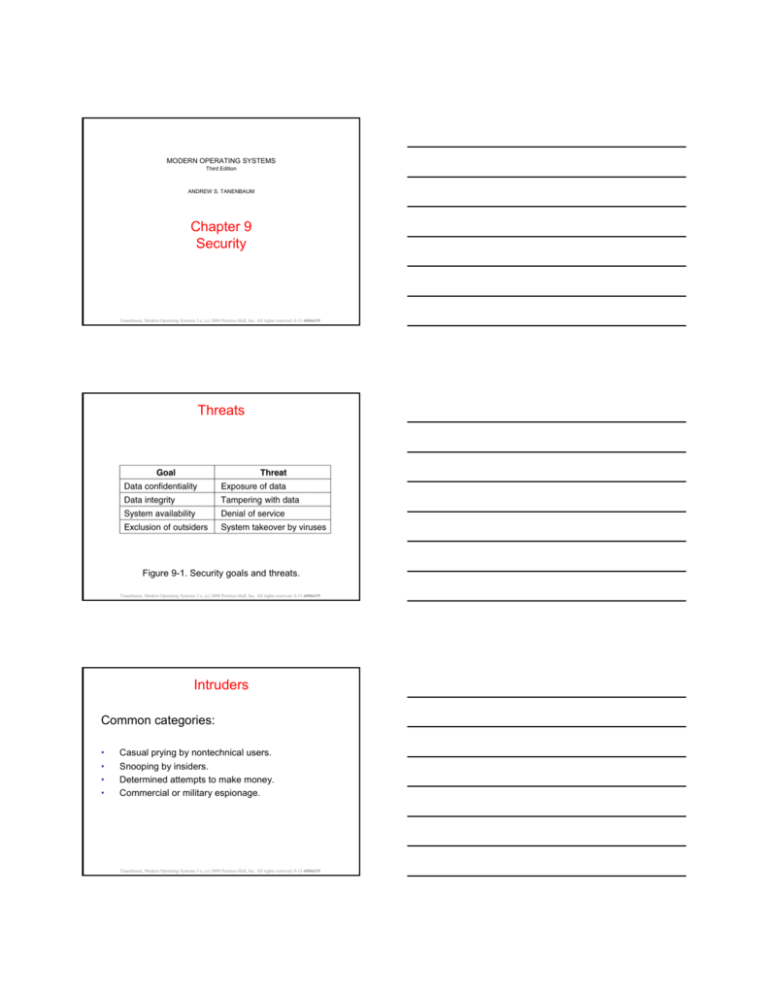
MODERN OPERATING SYSTEMS
Third Edition
ANDREW S. TANENBAUM
Chapter 9
Security
Tanenbaum, Modern Operating Systems 3 e, (c) 2008 Prentice-Hall, Inc. All rights reserved. 0-13-6006639
Threats
Figure 9-1. Security goals and threats.
Tanenbaum, Modern Operating Systems 3 e, (c) 2008 Prentice-Hall, Inc. All rights reserved. 0-13-6006639
Intruders
Common categories:
•
•
•
•
Casual prying by nontechnical users.
Snooping by insiders.
Determined attempts to make money.
Commercial or military espionage.
Tanenbaum, Modern Operating Systems 3 e, (c) 2008 Prentice-Hall, Inc. All rights reserved. 0-13-6006639
Accidental Data Loss
Common causes of accidental data loss:
•
•
•
Acts of God: fires, floods, earthquakes, wars, riots, or
rats gnawing backup tapes.
Hardware or software errors: CPU malfunctions,
unreadable disks or tapes, telecommunication errors,
program bugs.
Human errors: incorrect data entry, wrong tape or CDROM mounted, wrong program run, lost disk or tape, or
some other mistake.
Tanenbaum, Modern Operating Systems 3 e, (c) 2008 Prentice-Hall, Inc. All rights reserved. 0-13-6006639
Basics Of Cryptography
Figure 9-2. Relationship between the plaintext and the ciphertext.
Tanenbaum, Modern Operating Systems 3 e, (c) 2008 Prentice-Hall, Inc. All rights reserved. 0-13-6006639
Secret-Key Cryptography
Monoalphabetic substitution:
Plaintext: ABCDEFGHIJKLMNOPQRSTUVWXYZ
Ciphertext: QWERTYUIOPASDFGHJKLZXCVBNM
Tanenbaum, Modern Operating Systems 3 e, (c) 2008 Prentice-Hall, Inc. All rights reserved. 0-13-6006639
Public-Key Cryptography
•
Encryption makes use of an "easy" operation,
such as how much is
314159265358979 × 314159265358979?
•
Decryption without the key requires you to
perform a hard operation, such as what is the
square root of
3912571506419387090594828508241?
Tanenbaum, Modern Operating Systems 3 e, (c) 2008 Prentice-Hall, Inc. All rights reserved. 0-13-6006639
Digital Signatures
Figure 9-3. (a) Computing a signature block.
(b) What the receiver gets.
Tanenbaum, Modern Operating Systems 3 e, (c) 2008 Prentice-Hall, Inc. All rights reserved. 0-13-6006639
Protection Domains (1)
Figure 9-4. Three protection domains.
Tanenbaum, Modern Operating Systems 3 e, (c) 2008 Prentice-Hall, Inc. All rights reserved. 0-13-6006639
Protection Domains (2)
Figure 9-5. A protection matrix.
Tanenbaum, Modern Operating Systems 3 e, (c) 2008 Prentice-Hall, Inc. All rights reserved. 0-13-6006639
Protection Domains (3)
Figure 9-6. A protection matrix with domains as objects.
Tanenbaum, Modern Operating Systems 3 e, (c) 2008 Prentice-Hall, Inc. All rights reserved. 0-13-6006639
Access Control Lists (1)
Figure 9-7. Use of access control lists to manage file access.
Tanenbaum, Modern Operating Systems 3 e, (c) 2008 Prentice-Hall, Inc. All rights reserved. 0-13-6006639
Access Control Lists (2)
Figure 9-8. Two access control lists.
Tanenbaum, Modern Operating Systems 3 e, (c) 2008 Prentice-Hall, Inc. All rights reserved. 0-13-6006639
Capabilities (1)
Figure 9-9. When capabilities are used,
each process has a capability list.
Tanenbaum, Modern Operating Systems 3 e, (c) 2008 Prentice-Hall, Inc. All rights reserved. 0-13-6006639
Capabilities (2)
Figure 9-10. A cryptographically protected capability.
Tanenbaum, Modern Operating Systems 3 e, (c) 2008 Prentice-Hall, Inc. All rights reserved. 0-13-6006639
Capabilities (3)
Examples of generic rights:
•
•
•
•
Copy capability: create a new capability for the same
object.
Copy object: create a duplicate object with a new
capability.
Remove capability: delete an entry from the C-list;
object unaffected.
Destroy object: permanently remove an object and a
capability.
Tanenbaum, Modern Operating Systems 3 e, (c) 2008 Prentice-Hall, Inc. All rights reserved. 0-13-6006639
Trusted Systems
•
Consider reports of viruses, worms, etc.
•
Two naive (but logical) questions:
– Is it possible to build a secure computer system?
– If so, why is it not done?
Tanenbaum, Modern Operating Systems 3 e, (c) 2008 Prentice-Hall, Inc. All rights reserved. 0-13-6006639
Trusted Computing Base
Figure 9-11. A reference monitor.
Tanenbaum, Modern Operating Systems 3 e, (c) 2008 Prentice-Hall, Inc. All rights reserved. 0-13-6006639
Formal Models of Secure Systems
Figure 9-12. (a) An authorized state. (b) An unauthorized state.
Tanenbaum, Modern Operating Systems 3 e, (c) 2008 Prentice-Hall, Inc. All rights reserved. 0-13-6006639
The Bell-La Padula Model (1)
Rules for the Bell-La Padula model:
•
•
The simple security property: A process running at
security level k can read only objects at its level or
lower.
The * property: A process running at security level k
can write only objects at its level or higher.
Tanenbaum, Modern Operating Systems 3 e, (c) 2008 Prentice-Hall, Inc. All rights reserved. 0-13-6006639
The Bell-La Padula Model (2)
Figure 9-13. The Bell-La Padula multilevel security model.
Tanenbaum, Modern Operating Systems 3 e, (c) 2008 Prentice-Hall, Inc. All rights reserved. 0-13-6006639
The Biba Model
Rules for the Biba model:
•
•
The simple integrity principle: A process running at
security level k can write only objects at its level or
lower (no write up).
The integrity * property: A process running at
security level k can read only objects at its level or
higher (no read down).
Tanenbaum, Modern Operating Systems 3 e, (c) 2008 Prentice-Hall, Inc. All rights reserved. 0-13-6006639
Covert Channels (1)
Figure 9-14. (a) The client, server, and collaborator processes. (b)
The encapsulated server can still leak to the collaborator via
covert channels.
Tanenbaum, Modern Operating Systems 3 e, (c) 2008 Prentice-Hall, Inc. All rights reserved. 0-13-6006639
Covert Channels (2)
Figure 9-15. A covert channel using file locking.
Tanenbaum, Modern Operating Systems 3 e, (c) 2008 Prentice-Hall, Inc. All rights reserved. 0-13-6006639
Covert Channels (3)
Figure 9-16. (a) Three zebras and a tree. (b) Three zebras, a tree,
and the complete text of five plays by William Shakespeare.
Tanenbaum, Modern Operating Systems 3 e, (c) 2008 Prentice-Hall, Inc. All rights reserved. 0-13-6006639
Authentication
General principles of authenticating users:
•
•
•
Something the user knows.
Something the user has.
Something the user is.
Tanenbaum, Modern Operating Systems 3 e, (c) 2008 Prentice-Hall, Inc. All rights reserved. 0-13-6006639
Authentication Using Passwords
Figure 9-17. (a) A successful login.
(b) Login rejected after name is entered.
(c) Login rejected after name and password are typed.
Tanenbaum, Modern Operating Systems 3 e, (c) 2008 Prentice-Hall, Inc. All rights reserved. 0-13-6006639
How Crackers Break In
Figure 9-18. How a cracker broke into a U.S. Department of
Energy computer at LBL.
Tanenbaum, Modern Operating Systems 3 e, (c) 2008 Prentice-Hall, Inc. All rights reserved. 0-13-6006639
UNIX Password Security
Figure 9-19. The use of salt to defeat precomputation
of encrypted passwords.
Tanenbaum, Modern Operating Systems 3 e, (c) 2008 Prentice-Hall, Inc. All rights reserved. 0-13-6006639
Challenge-Response Authentication
The questions should be chosen so that the user
does not need to write them down.
Examples:
•
•
•
Who is Marjolein’s sister?
On what street was your elementary school?
What did Mrs. Woroboff teach?
Tanenbaum, Modern Operating Systems 3 e, (c) 2008 Prentice-Hall, Inc. All rights reserved. 0-13-6006639
Authentication Using a Physical Object
Figure 9-20. Use of a smart card for authentication.
Tanenbaum, Modern Operating Systems 3 e, (c) 2008 Prentice-Hall, Inc. All rights reserved. 0-13-6006639
Authentication Using Biometrics
Figure 9-21. A device for measuring finger length.
Tanenbaum, Modern Operating Systems 3 e, (c) 2008 Prentice-Hall, Inc. All rights reserved. 0-13-6006639
Trap Doors
Figure 9-22. (a) Normal code. (b) Code with a trap door inserted.
Tanenbaum, Modern Operating Systems 3 e, (c) 2008 Prentice-Hall, Inc. All rights reserved. 0-13-6006639
Login Spoofing
Figure 9-23. (a) Correct login screen. (b) Phony login screen.
Tanenbaum, Modern Operating Systems 3 e, (c) 2008 Prentice-Hall, Inc. All rights reserved. 0-13-6006639
Exploiting Code Bugs
Example steps to exploit a bug:
•
•
•
•
•
•
Run port scan to find machines that accept telnet connections.
Try to log in by guessing login name and password combinations.
Once in, run the flawed program with input that triggers the bug.
If the buggy program is SETUID root, create a SETUID root shell.
Fetch and start a zombie program that listens to an IP port for cmds.
Arrange that the zombie program is started when the system reboots.
Tanenbaum, Modern Operating Systems 3 e, (c) 2008 Prentice-Hall, Inc. All rights reserved. 0-13-6006639
Buffer Overflow Attacks
Figure 9-24. (a) Situation when the main program is running.
(b) After the procedure A has been called.
(c) Buffer overflow shown in gray.
Tanenbaum, Modern Operating Systems 3 e, (c) 2008 Prentice-Hall, Inc. All rights reserved. 0-13-6006639
Format String Attack
•
•
•
•
printf(“Hi, I’m a %s string”, “format”);
char* s = “Hi, I’m a format string”;
printf(s);
int x;
printf(“length? %n”, &x);
Now we can put values in arbitrary memory
locations…
Return to libc Attacks
Figure 9-25. (a) The stack before the attack.
(b) The stack after the stack has been overwritten.
Tanenbaum, Modern Operating Systems 3 e, (c) 2008 Prentice-Hall, Inc. All rights reserved. 0-13-6006639
Code Injection Attacks
Figure 9-26. Code that might lead to a code injection attack.
Tanenbaum, Modern Operating Systems 3 e, (c) 2008 Prentice-Hall, Inc. All rights reserved. 0-13-6006639
Malware
Can be used for a form of blackmail.
Example: Encrypts files on victim disk, then
displays message …
Greetings from General Encryption
To purchase a decryption key for your hard disk, please send $100 in small
unmarked bills to Box 2154, Panama City, Panama.
Thank you. We appreciate your business.
Tanenbaum, Modern Operating Systems 3 e, (c) 2008 Prentice-Hall, Inc. All rights reserved. 0-13-6006639
Types of Viruses
•
•
•
•
•
•
•
•
Companion virus
Executable program virus
Parasitic virus
Memory-resident virus
Boot sector virus
Device driver virus
Macro virus
Source code virus
Tanenbaum, Modern Operating Systems 3 e, (c) 2008 Prentice-Hall, Inc. All rights reserved. 0-13-6006639
Executable Program Viruses (1)
...
Figure 9-27. A recursive procedure that finds
executable files on a UNIX system.
Tanenbaum, Modern Operating Systems 3 e, (c) 2008 Prentice-Hall, Inc. All rights reserved. 0-13-6006639
Executable Program Viruses (2)
...
Figure 9-27. A recursive procedure that finds
executable files on a UNIX system.
Tanenbaum, Modern Operating Systems 3 e, (c) 2008 Prentice-Hall, Inc. All rights reserved. 0-13-6006639
Parasitic Viruses
Figure 9-28. (a) An executable program. (b) With a virus at the
front. (c) With a virus at the end. (d) With a virus spread over
free space within the program.
Tanenbaum, Modern Operating Systems 3 e, (c) 2008 Prentice-Hall, Inc. All rights reserved. 0-13-6006639
Boot Sector Viruses
Figure 9-29. (a) After the virus has captured all the interrupt and
trap vectors. (b) After the operating system has retaken the
printer interrupt vector. (c) After the virus has noticed the loss
of the printer interrupt vector and recaptured it.
Tanenbaum, Modern Operating Systems 3 e, (c) 2008 Prentice-Hall, Inc. All rights reserved. 0-13-6006639
Spyware (1)
Description:
•
•
Surreptitiously loaded onto a PC without the owner’s
knowledge
Runs in the background doing things behind the
owner’s back
Tanenbaum, Modern Operating Systems 3 e, (c) 2008 Prentice-Hall, Inc. All rights reserved. 0-13-6006639
Spyware (2)
Characteristics:
•
•
•
•
Hides, victim cannot easily find
Collects data about the user
Communicates the collected information back to its
distant master
Tries to survive determined attempts to remove it
Tanenbaum, Modern Operating Systems 3 e, (c) 2008 Prentice-Hall, Inc. All rights reserved. 0-13-6006639
How Spyware Spreads
Possible ways:
•
•
Same as malware, Trojan horse
Drive-by download, visit an infected web site
• Web pages tries to run an .exe file
• Unsuspecting user installs an infected toolbar
• Malicious activeX controls get installed
Tanenbaum, Modern Operating Systems 3 e, (c) 2008 Prentice-Hall, Inc. All rights reserved. 0-13-6006639
Actions Taken by Spyware
•
•
•
•
•
•
•
•
•
Change the browser’s home page.
Modify the browser’s list of favorite (bookmarked) pages.
Add new toolbars to the browser.
Change the user’s default media player.
Change the user’s default search engine.
Add new icons to the Windows desktop.
Replace banner ads on Web pages with those the spyware picks.
Put ads in the standard Windows dialog boxes
Generate a continuous and unstoppable stream of pop-up ads.
Tanenbaum, Modern Operating Systems 3 e, (c) 2008 Prentice-Hall, Inc. All rights reserved. 0-13-6006639
Types of Rootkits (1)
•
•
•
•
•
Firmware rootkits
Hypervisor rootkits
Kernel rootkits
Library rootkits
Application rootkits
Tanenbaum, Modern Operating Systems 3 e, (c) 2008 Prentice-Hall, Inc. All rights reserved. 0-13-6006639
Types of Rootkits (2)
Figure 9-30. Five places a rootkit can hide.
Tanenbaum, Modern Operating Systems 3 e, (c) 2008 Prentice-Hall, Inc. All rights reserved. 0-13-6006639
Firewalls
Figure 9-31. A simplified view of a hardware firewall
protecting a LAN with three computers.
Tanenbaum, Modern Operating Systems 3 e, (c) 2008 Prentice-Hall, Inc. All rights reserved. 0-13-6006639
Virus Scanners (1)
Figure 9-32. (a) A program. (b) An infected program.
(c) A compressed infected program. (d) An encrypted virus.
(e) A compressed virus with encrypted compression code.
Tanenbaum, Modern Operating Systems 3 e, (c) 2008 Prentice-Hall, Inc. All rights reserved. 0-13-6006639
Virus Scanners (2)
Figure 9-33. Examples of a polymorphic virus.
Tanenbaum, Modern Operating Systems 3 e, (c) 2008 Prentice-Hall, Inc. All rights reserved. 0-13-6006639
Antivirus and Anti-Antivirus Techniques
•
•
•
•
Virus scanners
Integrity checkers
Behavioral checkers
Virus avoidance
Tanenbaum, Modern Operating Systems 3 e, (c) 2008 Prentice-Hall, Inc. All rights reserved. 0-13-6006639
Code Signing
Figure 9-34. How code signing works.
Tanenbaum, Modern Operating Systems 3 e, (c) 2008 Prentice-Hall, Inc. All rights reserved. 0-13-6006639
Jailing
Figure 9-35. The operation of a jail.
Tanenbaum, Modern Operating Systems 3 e, (c) 2008 Prentice-Hall, Inc. All rights reserved. 0-13-6006639
Model-Based Intrusion Detection
Figure 9-36. (a) A program. (b) System call graph for (a).
Tanenbaum, Modern Operating Systems 3 e, (c) 2008 Prentice-Hall, Inc. All rights reserved. 0-13-6006639
Sandboxing
Figure 9-37. (a) Memory divided into 16-MB sandboxes.
(b) One way of checking an instruction for validity.
Tanenbaum, Modern Operating Systems 3 e, (c) 2008 Prentice-Hall, Inc. All rights reserved. 0-13-6006639
Interpretation
Figure 9-38. Applets can be interpreted by a Web browser.
Tanenbaum, Modern Operating Systems 3 e, (c) 2008 Prentice-Hall, Inc. All rights reserved. 0-13-6006639
Java Security (1)
JVM byte code verifier checks if the applet obeys
certain rules:
• Does the applet attempt to forge pointers?
•
•
•
•
Does it violate access restrictions on private-class
members?
Does it try to use a variable of one type as another
type?
Does it generate stack overflows? underflows?
Does it illegally convert variables of one type to
another?
Tanenbaum, Modern Operating Systems 3 e, (c) 2008 Prentice-Hall, Inc. All rights reserved. 0-13-6006639
Java Security (2)
Figure 9-39. Some examples of protection
that can be specified with JDK 1.2.
Tanenbaum, Modern Operating Systems 3 e, (c) 2008 Prentice-Hall, Inc. All rights reserved. 0-13-6006639

